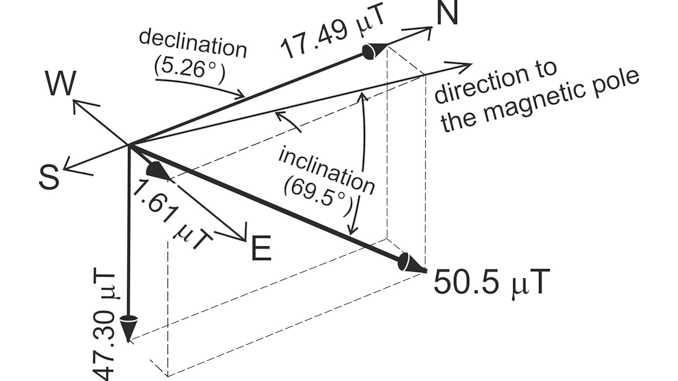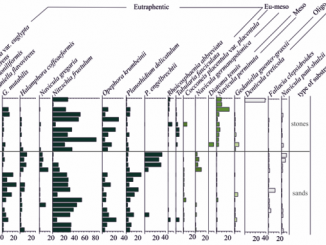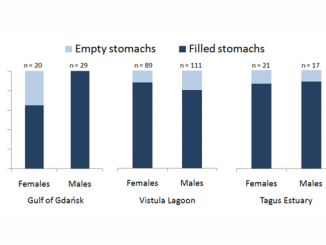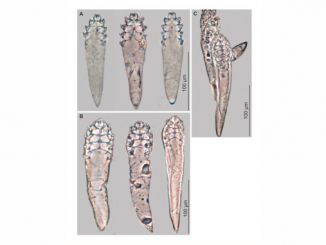
Paper category: Review paper
Corresponding author: Zbigniew Otremba (z.otremba@wm.umg.edu.pl)
DOI: 10.2478/ohs-2019-0018
Received: 18/09/2018
Accepted: 20/11/2018
Full text: here
Citation (APA style): Otremba, Z., Jakubowska, M., Urban-Malinga, B., et al. (2019). Potential effects of electrical energy transmission – the case study from the Polish Marine Areas (southern Baltic Sea). Oceanological and Hydrobiological Studies, 48(2), pp. 196-208. Retrieved 3 Oct. 2019, from doi:10.1515/ohs-2019-0018
Abstract
The operation of offshore wind turbines and electricity transmission through submarine cables over long distances generate electromagnetic or static magnetic fields (depending on the technical solution) that may modify the natural geomagnetic field and cause induced electric and electromagnetic fields in the water. The present study synthesizes the current knowledge and speculates on the possible environmental impact of electrical energy transfer based on the example of the Polish Marine Areas (southern Baltic Sea). We review the possible effects of the electrical energy induction and transfer against the existing and planned wind turbine installations. Furthermore, we consider different cable design variants as a way of environmental impact mitigation. Possible impacts of induced magnetic fields on marine organisms and, consequently, on the ecosystem functioning are also addressed.
Zbigniew Otremba
Magdalena Jakubowska
Barbara Urban-Malinga
Eugeniusz Andrulewicz
References
Andrulewicz, E., Gajewski, J., Kuzebski, E., Otremba, Z., Radtke, K. et al. (2013). Potential effects of wind farms on ichthyofauna and fishery in the Polish Marine Areas (in Polish) In B. Więcaszek (Ed.), The exploitation of marine resources. The maritime economy and scientific potential (pp. 111–132). West Pomeranian University of Technology, Szczecin.
Andrulewicz, E., Napierska, D. & Otremba, Z. (2003). The environmental effects of the installation and functioning of the submarine SwePol Link HVDC transmission line: a case study of the Polish Marine Area of the Baltic Sea. J. Sea Res. 49: 337–345. DOI: 10.1016/S1385-1101(03)00020-0.
Andrulewicz, E., Otremba, Z. & Kamińska, K. (2010). Ongoing Technical Activities and Conservation Measures in Marine Spatial Planning within Polish Marine Areas. Pol. J. Environ. Stud. 19(3): 553–563.
Ardelean, M., & Minnebo, P. (2015). HVDC submarine power cables in the world. European Commission, JRC Technical Report – 2015.
Arendse, M.C. & Kruyswijk, C.J. (1981). Orientation of Talitrus saltator to magnetic fields. Neth. J. Sea Res. 15(1): 23–32. DOI: 10.1016/0077-7579(81)90003-x.
Bergström, L., Kautsky, L., Malm, T., Rosenberg, R., Wahlberg, M. et al. (2014) Effects of offshore wind farms on marine wildlife – a generalized impact assessment. Environ. Res. Lett. 9(3): 034012. DOI: 10.1088/1748-9326/9/3/034012.
Bevelhimer, M.S., Cada, G.F., Fortner, A.M., Schweizer, P.E. & Riemer, K. (2013). Behavioral responses of representative freshwater fish species to electromagnetic fields. Trans. Am. Fish. Soc. 142(3): 802–813. DOI: 10.1080/00028487.2013.778901.
Bochert, R. & Zettler, M.L. (2004). Long‐term exposure of several marine benthic animals to static magnetic fields. Bioelectromagnetics 25(7): 498–502. DOI: 10.1002/bem.20019.
Brent, R.L. (1999). Reproductive and teratologic effects of low‐frequency electromagnetic fields: A review of in vivo and in vitro studies using animal models. Teratology 59(4): 261–286. DOI: 10.1002/(SICI)1096-9926(199904)59:43.0.CO;2-K.
Cain, S.D., Wang, J.H. & Lohmann, K.J. (2006). Immunochemical and electrophysiological analyses of magnetically responsive neurons in the mollusc Tritonia diomedea. J. Copm. Physiol. A 192(3): 235–245. DOI: 10.1007/s00359-005-0063-8.
Ciołek D., Matczak M., Piwowarczyk J., Rakowski M., Szefler K. et al. (2018). Ocean Coast. Manage. 166: 113–124. DOI: 10.1016/j.ocecoaman.2018.07.001.
Chew, G.L. & Brown, G.E. (1989). Orientation of rainbow trout (Salmo gairdneri) in normal and null magnetic fields. Can. J. Zool. 67(3): 641–643. DOI: 10.1139/z89-092.
Delgado, J.M., Leal, J., Monteagudo, J.L. & Gracia, M.G. (1982). Embryological changes induced by weak, extremely low frequency electromagnetic fields. J. Anat. 134(3): 533–551.
Dittman, A. & Quinn, T. (1996). Homing in Pacific salmon: mechanisms and ecological basis. J. Exp. Biol. 199(1): 83–91.
EC 2013/35/EU of the European parliament and of the council of 26 June 2013 on the minimum health and safety requirements regarding the exposure of workers to the risks arising from physical agents (electromagnetic fields) and repealing. Directive 2004/40/EC.
EC MSFD. (2008). Directive 2008/56/EC.
Enger, P.S. (1992). Electroreception. In K. Døving & E. Reimers (Eds.): Fish physiology (pp. 130). Bergen: John Grieg Publishing. (In Norwegian).
Fey D.P., Greszkiewicz M., Otremba Z. & Andrulewicz E. (2019). Effect of static magnetic field on the hatching success, growth, mortality, and yolk-sac absorption of larval Northern pike Esox Lucius. Sci. Total Environ. 647: 1239–1244. DOI: 10.1016/j.scitotenv.2018.07.427.
Formicki, K. (1992). Respiratory movements of trout (Salmo trutta L.) larvae during exposure to magnetic field. Acta. Ichthyol. Piscat. 22(2): 149–154. DOI: 10.3750/aip1992.22.2.08.
Formicki, K., Sadowski, M., Tański, A., Korzelecka‐Orkisz, A. & Winnicki, A. (2004). Behaviour of trout (Salmo trutta L.) larvae and fry in a constant magnetic field. J. Appl. Ichthyol. 20(4): 290–294. DOI: 10.1111/j.1439-0426.2004.00556.x.
Formicki, K., Szulc, J., Korzelecka-Orkisz, A., Tański, A., Kurzydłowski, J.K. et al. (2015). The effect of a magnetic field on trout (Salmo trutta Linnaeus, 1758) sperm motility parameters and fertilisation rate. J. Appl. Ichthyol. 31(S1): 136–146. DOI: 10.1111/jai.12737.
Formicki, K., Szulc, J., Tański, A., Korzelecka-Orkisz, A., Witkowski, A. et al. (2013). The effect of static magnetic field on Danube huchen, Hucho hucho (L.) sperm motility parameters. Arch. Pol. Fisheries. 21(3): 189–197. DOI: 10.2478/aopf-2013-0016.
Formicki, K., Tański, A. & Winnicki, A. (2002). Effects of magnetic field on the direction of fish movement under natural conditions. General Assembly URCI, Maastricht, pp. 1–3.
Formicki, K. & Winnicki, A. (1998). Reactions of fish embryos and larvae to constant magnetic fields. Ital. J. Zool. 65(S1): 479–482. DOI: 10.1080/11250009809386870.
Formicki, K. & Perkowski, T. (1998). The effect of a magnetic field on the gas exchange in rainbow trout Oncorhynchus mykiss embryos (Salmonidae). Ital. J. Zool. 65(S1): 475–477. DOI: 10.1080/11250009809386869.
GESAMP – Group of Experts on the Scientific Aspects of Marine Environmental Protection (1991). GESAMP Reports and Studies No. 47. Retrieved September 17, 2018, from http://www.fao.org/docrep/006/u3100e/u3100e00.htm
Ghodbane, S., Lahbib, A., Sakly, M. & Abdelmelek, H. (2013). Bioeffects of static magnetic fields: oxidative stress, genotoxic effects, and cancer studies. BioMed. Res. Int. 2013: 1–12. DOI: 10.1155/2013/602987.
Gill, A.B., Gloyne-Philips, I., Kimber, J. & Sigray, P. (2014). Marine renewable energy, electromagnetic (EM) fields and EM-sensitive animals. In M.A. Shields & A.I.L. Payne (Eds.), Marine Renewable Energy Technology and Environmental Interactions (pp. 61–79). Dordrecht: Springer.
Gill, A.B. (2005). Offshore renewable energy – ecological implications of generating electricity in the coastal zone. J. Appl. Ichthyol. 42: 605–615. DOI: 10.1111/j.1365-2664.2005.01060.x.
GOH (Geophysical Observatory in Hel). (2018). INTERMAGNET magnetograms: Magnetogram for Hel, 20 May 2018. Retrieved November 15, 2018, from http://rtbel.igf.edu.pl/
Hanson, M. & Westerberg, H. (1987). Occurrence of magnetic material in teleosts. Comp. Physiol. A 86(1): 169–172. DOI: 10.1016/0300-9629(87)90296-9.
HELCOM. (2007). HELCOM Baltic Sea action plan. Krakow, Poland, 15, 2007.
HELCOM. (2009). Biodiversity in the Baltic Sea: An Integrated Thematic Assessment on Biodiversity and Nature Conservation in the Baltic Sea. Executive Summary. Helsinki Commission, Baltic Marine Environment Protection Commission.
Hellinger, J. & Hoffmann, K.P. (2012). Magnetic field perception in the rainbow trout Oncorynchus mykiss: magnetite mediated, light dependent or both? J. Comp. Physiol. A 198(8): 593–605. DOI: 10.1007/s00359-012-0732-3.
Hulot, G., Finlay, C.C., Constable, C.G., Olsen, N. & Mandea, M. (2010). The magnetic field of planet Earth. Space Sci. Rev. 152(1–4): 159–222.
Johansson, S.G., Liljestrand, L., Krogh, F., Karlstrand, J. & Hanson, J. (2005). AC cable solutions for offshore wind energy. Copenhagen Offshore Wind Conference 1–10.
Kalmijn, A.J. (1978). Experimental evidence of geomagnetic orientation in elasmobranch fishes. In K. Schmidt-Koenig & W.T. Keeton (Eds.), Animal Migration, Navigation and Homing (pp. 347–355), Berlin: Springer.
Karlsson, L. (1984). Migration of European silver eels, Anguilla anguilla. Orientation to the earth’s magnetic field and pulp mill effluents, particularly in the Baltic. Acta Universitatis Upsaliensis 745: 5–24.
Kirschvink, J.L. (1997). Magnetoreception: homing in on vertebrates. Nature 390(6658): 339–340. DOI: 10.1038/36986.
Kirschvink, J.L., Kobayashi-Kirschvink, A., Diaz-Ricci, J.C. & Kirschvink, S.J. (1992). Magnetite in human tissues: a mechanism for the biological effects of weak ELF magnetic fields. Bioelectromagnetics 13(S1): 101–113. DOI: 10.1002/bem.2250130710.
Lerchl, A., Zachmann, A., Ather Ali, M. & Reiter, R.J. (1998). The effects of pulsing magnetic fields on pineal melatonin synthesis in a teleost fish (brook trout, Salvelinus fontinalis). Neurosci. Lett. 256(3): 171-173. DOI: 10.1016/s0304-3940(98)00778-2
Levin, M. & S. Ernst. (1995). Applied AC and DC Magnetic Fields Cause Alterations in the Mitotic Cycle of Early Sea Urchin Embryos. Bioelectromagnetics 16(4): 231–240. DOI: 10.1002/bem.2250160405.
Loghmannia, J., Heidari, B., Rozati, S.A. & Kazemi, S. (2015). The physiological responses of the Caspian kutum (Rutilus frisii kutum) fry to the static magnetic fields with different intensities during acute and subacute exposures. Ecotoxicol. Environ. Saf. 111: 215–219. DOI: 10.1016/j.ecoenv.2014.10.020.
Lohmann, K.J., Putman, N.F. & Lohmann, C.M. (2008). Geomagnetic imprinting: a unifying hypothesis of long-distance natal homing in salmon and sea turtles. Proc. Nat. Acad. Sci. 105(49): 19096–19101. DOI: 10.1073/pnas.0801859105.
Lohmann, K.J. (1985). Geomagnetic field detection by the western Atlantic spiny lobster, Panulirus argus. Mar. Freshw. Behav. Physiol. 12(1): 1–7. DOI: 10.1080/10236248509378629.
Lohmann, K.J. & Willows, A.O. (1987). Lunar-modulated geomagnetic orientation by a marine mollusk. Science 235(4786): 331–334. DOI: 10.1126/science.3798115.
Malagoli, D., Gobba, F., & Ottaviani, E. (2003). Effects of 50-Hz magnetic fields on the signalling pathways of fMLP-induced shape changes in invertebrate immunocytes: The activation of an alternative “stress pathway”. Biochim. Biophys. Acta. 1620(1–3): 185–190. DOI: 10.1016/s0304-4165(02)00531-7.
Malagoli, D., Lusvardi, M., Gobba, F. & Ottaviani, E. (2004). 50 Hz magnetic fields activate mussel immunocyte p38 MAP kinase and induce HSP70 and 90. Comp. Biochem. Physiol. C 137(1): 75–79. DOI: 10.1016/j.cca.2003.11.007.
Mann, S., Sparks, N.H., Walker, M.M. & Kirschvink, J.L. (1988). Ultrastructure, morphology and organization of biogenic magnetite from sockeye salmon, Oncorhynchus nerka: implications for magnetoreception. J. Exp. Biol. 140(1): 35–49.
Meißner K., Schabelon H., Bellebaum J. & Sordyl H. (2006). Impacts of Submarine Cables on the Marine Environment – A Literature Review. Report by Institute of Applied Ecology (IfAO).
Moller, P. (1995). Electrical Fishes: History and Behavior. Chapman & Hall.
Molteno, T.C.A. & Kennedy, W.L. (2009). Navigation by Induction-Based Magnetoreception in Elasmobranch Fishes. J. Biophysics 1–6. DOI: 10.1155/2009/380976.
Montgomery, J.C. & Bodznick, D. (1999). Signals and noise in the elasmobranch electrosensory system. J. Exp. Biol. 202(10): 1349–1355.
Nakamura, T., Hirose, C., Hirose, R., Hirooka, S. & Sasaki, H. (2006). Observation of electrical fields in the shallow sea using the stainless steel electrode antenna system. Phys. Chem. Earth 31( 4–9): 352–355. DOI: 10.1016/j.pce.2006.02.037.
Nishi, T., Kawamura, G. & Matsumoto, K. (2004). Magnetic sense in the Japanese eel, Anguilla japonica, as determined by conditioning and electrocardiography. J. Exp. Biol. 207(17): 2965–2970. DOI: 10.1242/jeb.01131.
Öhman, M.C., Sigray, P. & Westerberg, H. (2007). Offshore windmills and the effects of electromagnetic fields on fish. AMBIO 36(8): 630–633. DOI: 10.1579/0044-7447(2007)36.
Otremba, Z. & Andrulewicz, E. (2014). Physical fields raised during construction and exploitation of wind farms – example of the Polish Marine Areas. Pol. Mar. Res. 21(4): 113–122. DOI: 10.2478/pomr-2014-0048.
Panagopoulos, D.J., Karabarbounis, A. & Margaritis, L.H. (2002). Mechanism for action of electromagnetic fields on cells. Biochem. Biophys. Res. Commun. 298(1): 95–102. DOI: 10.1016/s0006-291x(02)02393-8.
Perkowski, T. & Formicki, K. (1997). Effects of constant magnetic fields on respiration of rainbow trout (Oncorhynchus mykiss Walb.) embryos. Acta. Ichthyol. Piscat. 27(2): 41–56. DOI: 10.3750/aip1997.27.2.04.
Poleo, A.B.S., Johannessen, H.F. & Harboe, M. (2001). High Voltage Direct Current (HVDC) sea cables and sea electrodes: effects on marine life. University of Oslo.
Quinn, T.P. (1980). Evidence for celestial and magnetic compass orientation in lake migrating sockeye salmon fry. J. Comp. Physiol.137(3): 243–248. DOI: 10.1007/bf00657119.
Reina, F.G., Pascual, L.A. & Fundora, I.A. (2001). Influence of a stationary magnetic field on water relations in lettuce seeds. Part II: experimental results. Bioelectromagnetics 22(8): 596–602. DOI: 10.1002/bem.89.
Richardson, N.E., McCleave, J.D. & Albert, E.H. (1976). Effect of extremely low frequency electric and magnetic fields on locomotor activity rhythms of Atlantic salmon (Salmo salar) and American eels (Anguilla rostrata). Env. Poll. 10(1): 65–76. DOI: 10.1016/0013-9327(76)90096-3.
Rochalska, M. (2009) The influence of electromagnetic fields on flora and fauna. Medycyna Pracy 60: 43–50.
Rosen, A.D. (1993). Membrane response to static magnetic fields: effect of exposure duration. Biochim. Biophys. Acta 1148(2): 317–320. DOI: 10.1016/0005-2736(93)90145-p.
Rosen, A.D. (1996). Inhibition of calcium channel activation in GH3 cells by static magnetic fields. Biochim. Biophys. Acta 1282(1): 149–155. DOI: 10.1016/0005-2736(96)00053-3.
Rudervall, R., Charpentier, J.P. & Sharma, R. (2000). High voltage direct current (HVDC) transmission systems technology review paper. Energy week, 2000, 1–19.
Sadowski, M., Winnicki, A., Formicki, K., Sobociński, A. & Tański, A. (2007). The effect of magnetic field on permeability of egg shells of salmonid fishes. Acta. Ichthyol. Piscat. 37: 129–135. DOI: 10.3750/aip2007.37.2.10.
Schultz-Zehden, A. & Matczak, M. (2012). SUBMARINER Compendium: An assessment of innovative and sustainable uses of Baltic marine resources. Gdansk: Maritime Institute in Gdansk.
Simkó, M. (2007). Cell Type Specific Redox Status is Responsible for Diverse Electromagnetic Field Effects. Curr. Med. Chem. 14(10): 1141–1152. DOI: 10.2174/092986707780362835.
Skauli, K.S., Reitan, J.B. & Walther, B.T. (2000). Hatching in zebrafish (Danio rerio) embryos exposed to a 50 Hz magnetic field. Bioelectromagnetics 21(5): 407–410. DOI: 10.1002/1521-186X(200007)21:5 3.0.CO;2-V.
Stankevičiūtė, M., Jakubowska, M.., Pažusienėa, J., Makarasa, T., Otremba, Z. et al. (2019) Genotoxic and cytotoxic effects of 50 Hz 1 mT electromagnetic field on larval rainbow trout (Oncorhynchus mykiss), Baltic clam (Limecola balthica) and common ragworm (Hediste diversicolor). Aquatic Toxicology 208(2019): 109–117. DOI: 10.1016/j.aquatox.2018.12.023.
Tański, A., Formicki, K., Śmietana, P., Sadowski, M. & Winnicki, A. (2005). Sheltering behaviour of spinycheek crayfish (Orconectes limosus) in the presence of an artificial magnetic field. Bull. Fr. Peche Piscicult. 376–377: 787–793. DOI: 10.1051/kmae:2005033.
Taormina, B., Bald, J., Want, A., Thouzeau, G., Lejart, M. et al. (2018). A review of the potential impact of submarine power cables on the marine environment: Knowledge gaps, recommendations and future directions. Renew. Sust. Energ. Rev. 96: 380–391. DOI: 10.1016/j.rser.2018.07.026.
Tesch, F.W. & Wendt, T. (1992). Influence of geomagnetism on the activity and orientation of eel, Anguilla, as evident from laboratory experiment. Aq. Ecol. Freshw. Fish. 1: 52–60. DOI: 10.1111/j.1600-0633.1992.tb00007.x.
Ueda, K., Maeda, Y., Koyama, M., Yaskawa, K. & Tokui, T. (1986). Magnetic remanences in salmonid fish. Nippon Suisan. Gakk. 52(2): 193–198. DOI: 10.2331/suisan.52.193.
Ugolini, A. (2005). Equatorial sandhoppers use body scans to detect the earth’s magnetic field. J. Com. Physiol. A 192(1): 45–49. DOI: 10.1007/s00359-005-0046-9.
Vaughan, T.E. & Weaver, J.C. (1998). Molecular change due to biomagnetic stimulation and transient magnetic fields: mechanical interference constraints on possible effects by cell membrane pore creation via magnetic particles. Bioelectroch. Bioenerg. 46(1): 121–128. DOI: 10.1016/s0302-4598(98)00096-8.
Vijayalaxmi & Obe, G. (2005). Controversial cytogenetic observations in mammalian somatic cells exposed to extremely low frequency electromagnetic radiation: A review and future research recommendations. Bioelectromagnetics 26(5): 412–430. DOI: 10.1002/bem.20111.
Wadas, R. (1978). Biomagnetyzm. Warszawa: Państwowe Wyd. Naukowe. (In Polish).
Webb, S.C. & Cox, C.S. (1984). Pressure and electrical fluctuations on the deep seafloor: background noise for seismic detection. Geophys. Res. Lett. 11: 967–970. DOI: 10.1029/gl011i010p00967.
Westerberg, H, & Begout-Anras, M.-L. (2000). Orientation of silver eel (Anguilla anguilla) in a disturbed geomagnetic field. In A. Moore & I. Russell (Eds.): Proceedings of the 3rd Conference on Fish Telemetry (pp. 149–158), Lowestoft: CEFAS.
Węsławski, J.M., Urbański, J., Kryla-Staszewska, L., Andrulewicz, E., Linkowski, T. et al. (2010). The different uses of sea space in Polish Marine Areas: is conflict inevitable? Oceanologia 52(3): 513–530. DOI: 10.5697/oc.52-3.513.
Wiltschko, R. & Wiltschko, W. (1995). Magnetic orientation in animals. Berlin: Springer-Verlag.
Winnicki, A., Korzelecka-Orkisz, A., Sobociński, A., Tański, A. & Formicki, K. (2004). Effects of the magnetic field on different forms of embryonic locomotor activity of northern pike, Esox lucius L. Acta. Ichthyol. Piscat. 34(2): 193–203. DOI: 10.3750/aip2004.34.2.07.
Wueringer, B.E., Jnr, L.S., Kajiura, S.M., Tibbetts, I.R., Hart, N.S. et al. (2012). Electric field detection in sawfish and shovelnose rays. PLoS One 7(7): e41605. DOI: 10.1371/journal.pone.0041605.
Zhadin, M.N. (2001). Review of Russian Literature on Biological Action of DC and Low-Frequency AC Magnetic Fields. Bioelectromagnetics 22: 27–45. DOI: 10.1002/1521-186X(200101)22:1 3.0.CO;2-2.
Zhan, X., Fang, J. & Zhang, B. (2018). Simulation and Analysis of Magnetic Field in HVDC Transmission Cable. IOP Conf. Ser.: Mat. Sci. Eng. 382: 032041, DOI: 10.1088/1757-899X/382/3/032041.




Bądź pierwszy, który skomentuje ten wpis